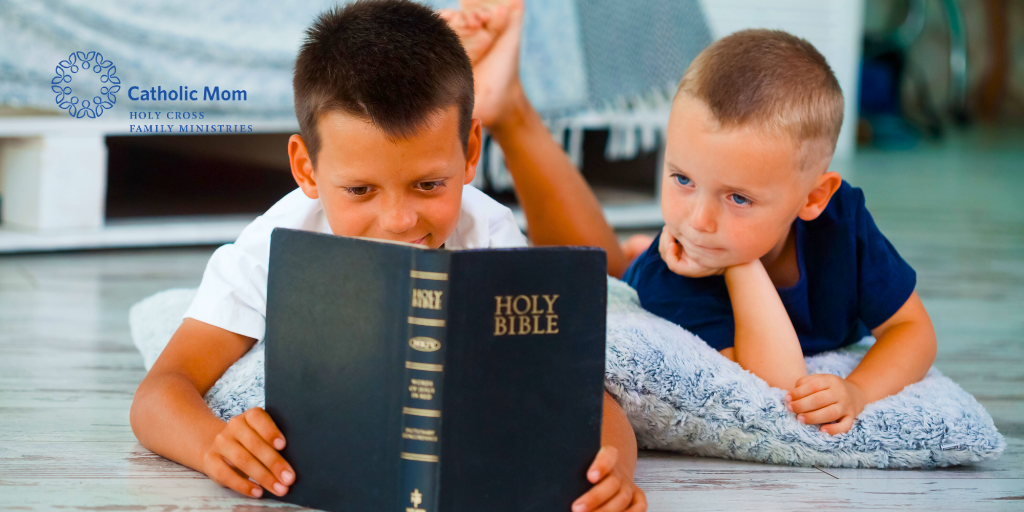
Caitrin Bennett offers four techniques for studying Scripture with young children.
There is a running joke that Catholics don’t know Scripture very well — and it is based on a grain of truth. Many of my Protestant friends studied the Bible much more than I did through their childhood and teenage years. They can quote verses they have memorized, tell you where you can find any of the famous Bible stories, and follow the thread of salvation history much better than I can.
But Scripture should be extremely important to us as Catholic Christians, too! It is the Word of God, and we should keep it ever on our minds, on our lips, and in our hearts. I wanted to make sure my kids knew and loved the Bible better than I did growing up. Here are some ways that we “do” Scripture in my home. I hope one or two of them can help you make Scripture part of your family culture, too!

Enjoy the Storytelling in Scripture
Young children love stories. Heroes, villains, action and adventure capture their imagination. So play off of this natural interest! The Bible is replete with compelling narratives, and there are many great sources out there to help you pull out individual stories. For babies and toddlers, find a short collection of famous Bible stories written in child-friendly language, with beautiful illustrations. Read these aloud frequently, using lots of expression and even voices for different characters.
Encourage your children to bring their favorite stories to their play by providing simple props (a basket for a baby doll after reading the story of Moses, for example) or just pointing out aspects of the child’s play setting that remind you of a Bible passage (“I wonder if this climbing tree is as tall as the one Zacchaeus climbed up to see Jesus pass by!”). Play reinforces children’s understanding of what they have heard.
For children older than five or so, though, I recommend getting a collection of Bible stories that does not use dumbed-down language. Kids should be hearing the actual words of Scripture as early as possible, while still having pictures and background information to help make the text more accessible. My kids and I love My Big Book of Catholic Bible Stories, illustrated by Natalie Carabetta.
Memorize Scripture
The more Scripture you have memorized, the more wisdom you can pull from when facing a difficult situation. Kids can start memorizing short, beautiful verses by the time they are four or five. Catholic Icing has a few sets of Scripture memory cards, including verses that we hear in our well-loved prayers and in the Mass. These have helped my kids see that our liturgy is truly steeped in Scripture!
Now that my daughter is eight, she has started memorizing longer passages, like psalms. We use a simple system for memory work: one binder per kid, with tabs for “currently memorizing,” “review weekly,” “review monthly,” and “up next.” Five minutes two or three times a week is all it takes to memorize lots of Scripture!
Look It Up
Besides any collections of Bible stories, your family should also have at least one full-text Bible in your home, easily accessible to older children. Once they have a decent grasp on reading, help them grow in ownership of Scripture by learning how to look up verses. Start by finding the beginning of the New Testament so they can feel how much thicker the Old Testament is than the New. Show them how to use any tabs or markings on the side of your Bible to move between books, and explore together how chapter and verse numbers work.
If kids have free access to the Bible, they will occasionally page through it and become more familiar with the major books of Scripture and the order they are in. If you have more than one reading child, get another copy (you can get study Bibles for about $5 on ThriftBooks) and have them race to see who can find a verse more quickly. Kids are very tactile, and there is just no substitute for a hard copy of God’s Word!
Maximize the Mass Readings
Even if you don’t read any other Scripture, your kids will hear several passages each week at Mass: one from the Old Testament, one from the Gospels, one from the rest of the New Testament, and a psalm, not to mention the Scripture in all the prayers and Mass parts. To maximize the impression this Scripture makes, try to read some or all of that to them a few days beforehand, or even on the way to Mass. You can find the daily Mass readings on many online sources, such as through the USCCB or EWTN. Then, at Mass, your kids’ eyes might just light up with familiarity at the story, or some inside joke you had together while reading it the first time. Maybe they will notice something new the second time through … or maybe you will!

Share your thoughts with the Catholic Mom community! You'll find the comment box below the author's bio and list of recommended articles.
Copyright 2025 Caitrin Bennett
Images: Canva
About the Author

Caitrin Bennett
Caitrin Bennett is a homeschooling mom of three young children, and the author of Holier Matrimony: Married Saints, Catholic Vows, and Sacramental Grace. Her blog at HolierMatrimony.com combines two of her passions: sharing the Church's beautiful teachings on marriage, and creative writing.


.png?width=1806&height=731&name=CatholicMom_hcfm_logo1_pos_871c_2728c%20(002).png)
Comments